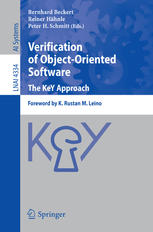

Most ebook files are in PDF format, so you can easily read them using various software such as Foxit Reader or directly on the Google Chrome browser.
Some ebook files are released by publishers in other formats such as .awz, .mobi, .epub, .fb2, etc. You may need to install specific software to read these formats on mobile/PC, such as Calibre.
Please read the tutorial at this link: https://ebookbell.com/faq
We offer FREE conversion to the popular formats you request; however, this may take some time. Therefore, right after payment, please email us, and we will try to provide the service as quickly as possible.
For some exceptional file formats or broken links (if any), please refrain from opening any disputes. Instead, email us first, and we will try to assist within a maximum of 6 hours.
EbookBell Team

5.0
58 reviewsLong gone are the days when program veri?cation was a task carried out merely by hand with paper and pen. For one, we are increasingly interested in proving actual program artifacts, not just abstractions thereof or core algorithms. The programs we want to verify today are thus longer, including whole classes and modules. As we consider larger programs, the number of cases to be considered in a proof increases. The creative and insightful parts of a proof can easily be lost in scores of mundane cases. Another problem with paper-and-pen proofs is that the features of the programming languages we employ in these programs are plentiful, including object-oriented organizations of data, facilities for specifying di?erent c- trol ?ow for rare situations, constructs for iterating over the elements of a collection, and the grouping together of operations into atomic transactions. These language features were designed to facilitate simpler and more natural encodings of programs, and ideally they are accompanied by simpler proof rules. But the variety and increased number of these features make it harder to remember all that needs to be proved about their uses. As a third problem, we have come to expect a higher degree of rigor from our proofs. A proof carried out or replayed by a machine somehow gets more credibility than one that requires human intellect to understand.